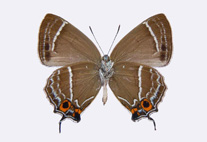Abstract
The tribe Satyrini is one of the most diverse groups of butterflies, but no robust phylogenetic hypothesis for this group has been achieved. Two rarely used 16s and 28s ribosomal and another seven protein-coding genes were used to reconstruct the phylogeny of the Satyrini, with further aim to evaluate the informativeness of the ribosomal genes. Our maximum parsimony (MP), maximum likelihood (ML) and Bayesian inference (BI) analyses consistently recovered three well-supported clades for the eleven sampled subtribes of Satyrini: clade I includes Eritina and Coenonymphina, being sister to the clade II + clade III; clade II contains Parargina, Mycalesina and Lethina, and the other six subtribes constitute clade III. The placements of the taxonomically unstable Davidina Oberthür and geographically restricted Paroeneis Moore in Satyrina are confirmed for the first time based on molecular evidence. The close relationships of Callerebia Butler, Loxerebia Watkins and Argestina Riley are well-supported. We suggest that Rhaphicera Butler belongs to Lethina. The partitioned Bremer support (PBS) values of MP analysis show that the 16s rDNA contributes well to the nodes representing all the taxa from subtribe to species levels, and the 28s rDNA is informative at the subtribe level. Furthermore, our ML analyses show that the ribosomal genes 16s rDNA and 28s rDNA are informative, because most node support values are lower in the ML tree after the removal of them than that in ML tree constructed based on the full nine-gene dataset. This indicates that some other ribosomal genes should be tentatively used through combining with traditionally used protein-coding genes in further analysis on phylogeny of Satyrini, providing that proper representatives are sampled.

